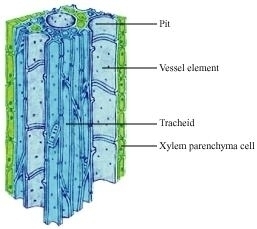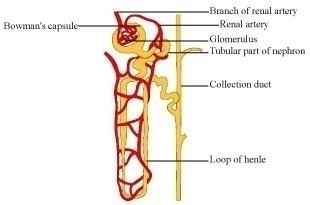NCERT Solution: Life Processes
The components of xylem tissue (tracheids and vessels) of roots, stems, and leaves are interconnected to form a continuous system of water-conducting channels that reaches all parts of the plant. Transpiration creates a suction pressure, as a result of which water is forced into the xylem cells of the roots. Then there is a steady movement of water from the root xylem to all the plant parts through the interconnected water-conducting channels.

Components of xylem tissue
Phloem transports food materials from the leaves to different parts of the plant body. The transportation of food in phloem is achieved by utilizing energy from ATP. As a result of this, the osmotic pressure in the tissue increases causing water to move into it. This pressure moves the material in the phloem to the tissues which have less pressure. This is helpful in moving materials according to the needs of the plant. For example, the food material, such as sucrose, is transported into the phloem tissue using ATP energy.

Components of phloem tissue
Nephrons are the basic filtering units of kidneys. Each kidney possesses large number of nephrons, approximately 1-1.5 million. The main components of the nephron are glomerulus, Bowman's capsule, and a long renal tubule.

Structure of a nephron
Functioning of a Nephron:
The blood enters the kidney through the renal artery, which branches into many capillaries associated with glomerulus.
The water and solute are transferred to the nephron at Bowman's capsule.
In the proximal tubule, some substances such as amino acids, glucose, and salts are selectively reabsorbed and unwanted molecules are added in the urine.
The filtrate then moves down into the loop of Henle, where more water is absorbed.
From here, the filtrate moves upwards into the distal tubule and finally to the collecting duct. Collecting duct collects urine from many nephrons.
The urine formed in each kidney enters a long tube called ureter. From ureter, it gets transported to the urinary bladder and then into the urethra.
Plants can get rid of excess of water by transpiration. Waste materials may be stored in the cell vacuoles or as gum and resin, especially in old xylem. It is also stored in the leaves that later fall off.
The amount of urine produced depends on the amount of excess water and dissolved wastes present in the body. Some other factors such as habitat of an organism and hormone such as Anti-diuretic hormone (ADH) also regulates the amount of urine produced.
The kidneys in human beings are a part of the system for
(a) nutrition.
(b) respiration.
(c) excretion.
(d) transportation.
Ans: (c) excretion.
The xylem in plants are responsible for
(a) transport of water.
(b) transport of food.
(c) transport of amino acids.
(d) transport of oxygen.
Ans: (a) transport of water.
The autotrophic mode of nutrition requires
(a) carbon dioxide and water.
(b) chlorophyll.
(c) sunlight.
(d) all of the above.
Ans: (d) all of the above.